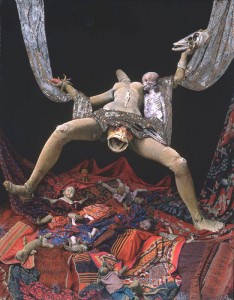« Reviews
The Archetypes of Charles Pfahl

Charles Pfahl, Archetype 100”x80” Oil, gold and silver leaf on canvas, 2000. Photo courtesy 101 exhibit.
101/exhibit
Design District - Miami
April 4 - May 2, 2009
By Yuleina Barredo
Anyone who recently visited the Galería 101/exhibit in Miami’s Design District was able to share in the dazzling pictorial that accompanies the work of Charles Pfahl. Since the 1970s, he has been considered one of the most influential realist artists in the United States.
At the age of twelve, in his native Ohio, his grandmother introduced him to oil painting and since then his loyalty to this technique has been absolute. Thus, we need to take a closer look at his artistic work, which in the midst of the myriad of expressive resources and technological support at the disposal of contemporary creators, remains true to the traditional canons of his craft.
Pfahl unfurls emotionally-charged symbolism developed based on a sinister perception of beauty that on occasion touches on the grotesque. In his pieces we approach a mise-en-scène conceived from the grandiloquence and coloring of huge pieces of cloth displayed scenographically. Like a dramatization of life itself, time flies, leaving in its tracks the remains of human presence: mutilated mannequins and dilapidated dolls. Based on recollections of his childhood and the nature of this phase, Pfahl warns us with a certain cruelty that said period seldom remains in memory as an innocent and happy remembrance.
In the piece Archetype, he reminds us that his vocation for realism does not allow him to leave any detail within the composition to chance. Each element has been conceived with such reality that it reaches its paroxysm in the texture of the fabric that supports the inert body of a decapitated mannequin, a sensation that can only be compared with the visual effect that three-dimensional images provoke. Focused on evident anthropological investigation from a collective conscience standpoint, he revisits universal mythology with its underlying symbols such as the fish head present in the iconography of Native Americans and the archetype of The Great Mother reinterpreted based on the legend of the vagina dentata, which maintains that a fish exists inside the female organ, an implausible argument wielded by some primitive cultures in order to deprive men and women of sexual pleasure.
In a conscious exploration of other genres of painting, the artist undertakes long hours of introspection in front of the mirror and then renders us his own image in a series of self-portraits, revealing to us the nature of the regression. Pfahl unveils himself from different perspectives, later framing these in kinds of installations that remind us of the retables characteristic of medieval times or of a referent closer in time such as the famous box-sculptures of the American, Joseph Cornell. Just as the Swiss artist, Jean Tinguely, did in his complex sculptural mechanisms, Phafl takes advantage of the visual impact of animal skeleton and skull representations to address the inevitable and finite cycle of existence.
Yuleina Barredo: Journalist and art critic.
Filed Under: Reviews


































